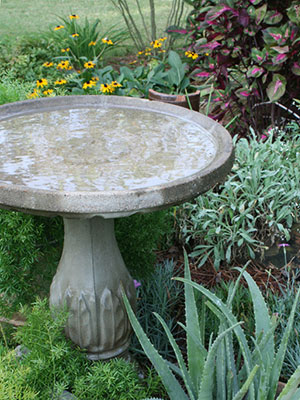April Tips & Tricks for South Florida Landscapes Butterflies & Birds
April In Your Garden
This is a great time to get out in the garden and do a little maintenance. You can divide clumps of bulbs, ornamental grasses, and herbaceous shrubs to expand and rejuvenate your garden this month. This is also a good time to add new things to your garden such as birdbaths & water stations which will promote wildlife in your garden.
Birdbaths

Birdbaths are the most popular way to provide water for wildlife. They can be homemade or commercial models. Birdbaths should be placed so that predators can’t sneak up on unsuspecting users. Keeping brush cover nearby offers protection and perches where birds can preen. Just be sure not to have low shrubbery too close—cats will use it for ambushes. In general, the lower the birdbath, the more open space there should be around it.
Birds prefer baths with textured bottoms for firm footing. You can cover smooth bottoms with pebbles or sand. Water in a birdbath should be no deeper than two to three inches in the middle, and the sides of the bath should slope gently so birds can easily climb in and out.
Birdbaths are available in materials as varied as concrete, terracotta, and plastic. Concrete models are expensive and cumbersome, but provide excellent footing for birds and will not budge in severe weather. A plastic birdbath may need to be secured against strong winds.
Keep the water in birdbaths clean and consistently available. Don’t use bleach or other chemicals to clean your birdbath—scrub it with a textured sponge every few days will remove algae.
Butterfly Watering Stations
Butterflies have special requirements for drinking. They take in liquids through their proboscis, a long, hollow tube that is sort of a modified tongue.
These insects are often seen “puddling,” or gathering at damp, sunny spots, where they draw moisture from mud or sand. Butterflies are incapable of drinking freestanding water, such as in a birdbath.
Use a coffee can or similar container to make a butterfly watering station. Put several inches of clean sand or earth in the bottom, sink it into the ground, and fill it with water. Place rocks in the middle and at the sides for use as
Ponds and Pools
A garden pond can attract a variety of wildlife. One with aquatic plants as well as vegetation around its edges is ideal. Animals that might be attracted to your garden pond include turtles, frogs, birds, snakes, lizards, and raccoons.
You can create a pond with a rubber liner, pre-formed pond, or a large tub—materials readily found at most garden centers. There are many easy-to-grow water plants; make sure you choose ones that will thrive in the light conditions and size of your pond. Consider incorporating koi or goldfish into your pond—but if you expect wildlife, make sure you create hiding places for the fish and don’t get too attached to them!
Make a small water hole in your yard for animals. You’ll be rewarded with fascinating sights and beautiful sounds, and you’ll help them survive dry times! Change the water regularly to keep mosquitoes from breeding there.
If you need help regarding your landscaping, we at Garden Services are fully licensed & insured to handle all your irrigation, landscaping, lawn maintenance and tree service needs whether it’s a residential, commercial landscaping or homeowner association property. If you ever have any comments or questions, please don’t hesitate to call or email me and I’ll be happy to answer any questions that you might have. Special thanks to UF/IFAS extension for some helpful information provided in this post. Until next month Happy Gardening!
